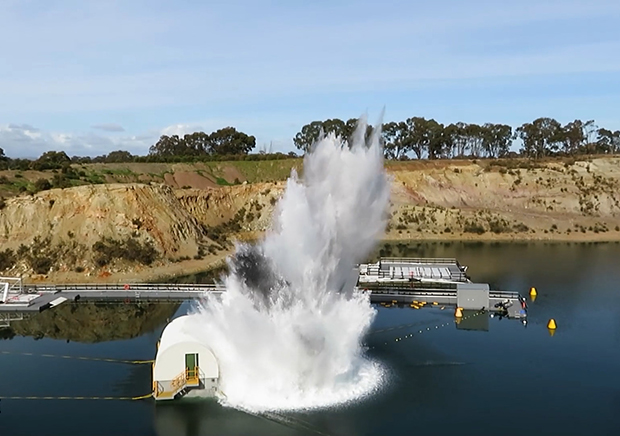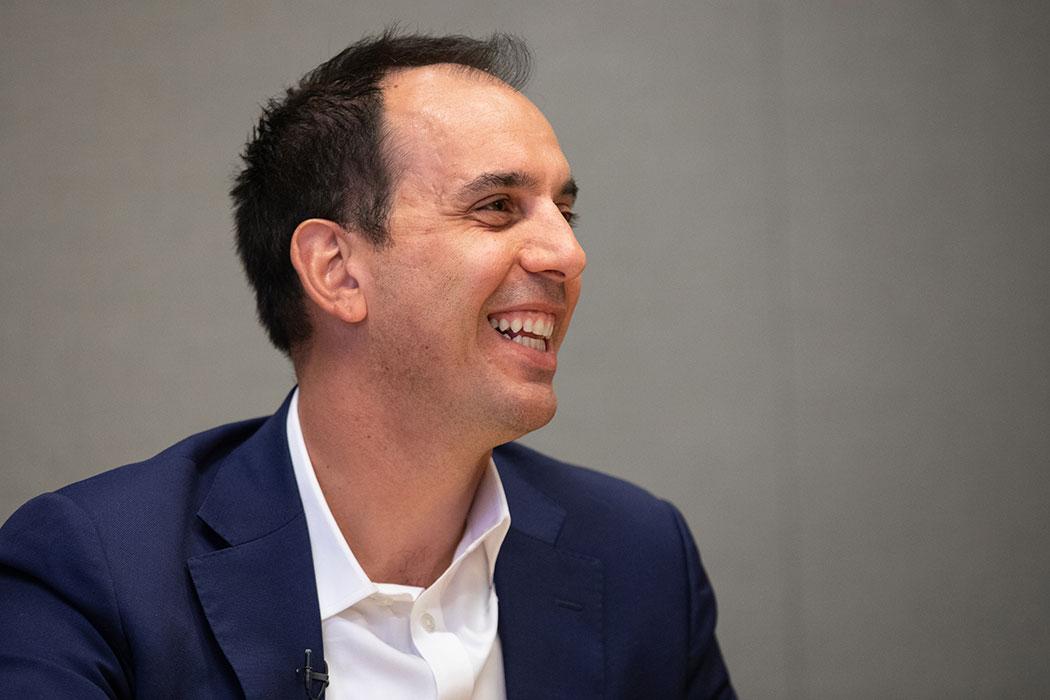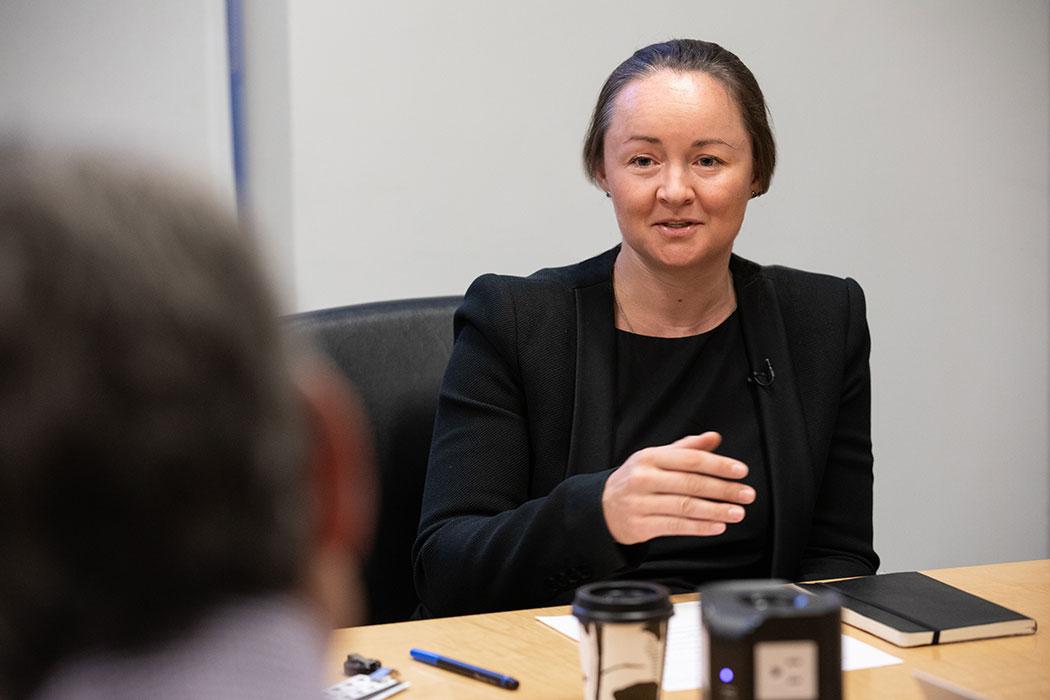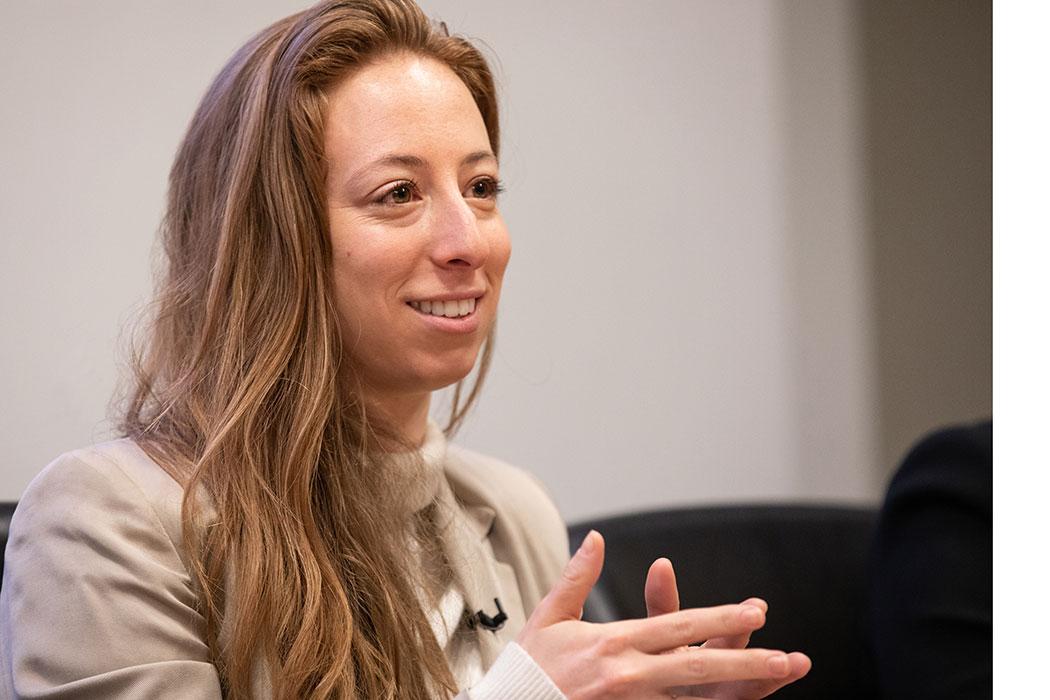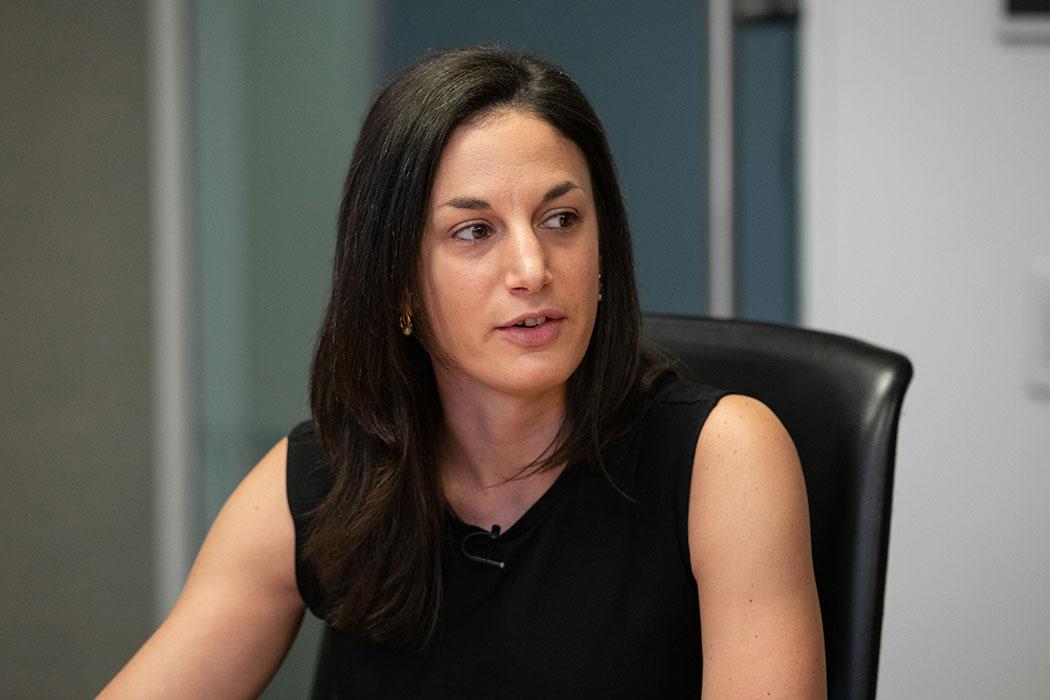
Resilience + Circular Economy: Cities Reimagined
What happens to this building when we’re done with it? An introduction to circular economic principles.
How can we rethink the way cities are designed, built and operated to address social, environmental and economic needs? For our 2019/2020 annual report, we convened members of the Urban Design Forum’s 2019 Class of Forefront Fellows to explore this question. Their fellowship project is investigating how design can address a social or political challenge in New York City in which race, class and climate change intersect. Here, they focus on the potential of circular urban systems.
What is a circular economic principle?
AMY Since the Industrial Revolution, we’ve been operating in a linear economy: we extract resources, make a product, use it and then throw it out, so it ends up in a landfill or the ocean. This is a wasteful and leaky way of operating. The circular economy upends this entire approach. It has three components. The first is to reduce consumption; the second is to design out the production of waste and pollution and enable reuse. Burning waste to generate energy for a city or community, and capturing the waste heat for heating, for example. Everyone more or less gets that idea. This helps keep products and materials in use at their highest value for as long as possible. And the third component is to regenerate natural systems.
REBECCA A paradox is that prior to the Industrial Revolution, our economies were circular. Because there was no mass production, we reused out of necessity. The Industrial Revolution defined a single bottom line – the life of the product itself – which could be achieved only by the linear model. Becoming circular means redefining who benefits from the process and making it more equitable all around.
AMY Parts of the developing world are striving for this linear economy because it’s a symbol of prosperity. But it should also go the other way around: indigenous people can teach us something useful. We saw this recently in Australia, where 5,000-year-old indigenous methods of fighting wildfires proved more effective than the technologies we deployed.
Measuring reduction in consumption is often straightforward. How do you measure the other benefits?
MICHAEL Circular systems form a Venn diagram of equally weighted economic, environmental and social benefits. We do a good job of quantifying economic values, such as dollars saved or energy consumed. Environmental benefits can be demonstrated with a life-cycle analysis to show the amount of water saved, waste reduced, pollution eliminated, jobs created value to society, etc. Environmental, economic and social benefits are often interwoven. By flipping the “take-make-waste” linear way we operate now, we can design all our systems to give waste a similar financial value. A simple example: this weekend I bought a waterproof beach pouch made of used bicycle tubes.
Key to the circular systems approach is considering ease of upcycling at the time of design or production. If we begin a product design with the question "what is the second and third life of this product?" we might make different decisions. It's taking a more systems view than just “what do we do with this product next?” Manufacturers don't have the liability of dealing with waste. One approach people are talking about is having manufacturers become responsible for the waste related to their products. New York, for example, spends $300 million per year to cart out waste and shifts the environmental liability to a location thousands of miles away. There's a huge potential for financial, environmental and social gain.
AMY Speaking of liability – the potential exists for a kind of circular economy scorecard, like nutrition labeling on food. Any chain restaurant has to tell you the caloric content of the meal you order. One day, we could know the environmental, social and economic impact of a façade design, for example. When you buy a car in the United States, the Environmental Protection Agency requires disclosure of its fuel efficiency. What about the car’s carbon footprint? Same for buildings.
REBECCA The fashion industry has been a leader in this expanded circle of responsibility because it's become a marketing tool. At Patagonia, “this sweater used to be plastic bottles” is one example, as is their program to repair and recycle worn-out clothing. Consumers are more aware than ever about transparency in the manufacturing supply chain – where is the factory? Under what conditions are people working? Where is the waste going?
For the average person, understanding that life cycle for the building stock might be harder. The prevalent mindset is to design buildings to last forever in their current use. Instead, what would it mean to design in the agility to accommodate future building systems or programs?
AMY One area ripe for revision is how we deal with water in the built environment. Water is collected in drains and during heavy rains and floods can combine with sewage and discharge into our waterways. It’s also piped great distances. One opportunity is to capture rainwater on-site and use it locally for irrigation instead of piping in water from reservoirs to water our green spaces. It means thinking “how can we use this?” instead of “how can we get rid of this?”
What would it mean to design in the agility to accommodate future building systems or programs?
How do you persuade a skeptical owner or developer that these approaches are worth the investment?
MICHAEL People often assume there’s an insurmountable upfront cost before they even understand what’s involved. Once they see that circular systems are self-incentivizing and apply them, they realize the upfront costs decrease and intrinsic value increases.
REBECCA At the New York City Public Design Commission, we review projects at the stage when teams are selecting materials or developing plant palettes for a streetscape. We always discuss cost, maintenance and operations, and there are certain proven means and methods. Opening up options for less-proven or lesser-known methods can be a tougher conversation, but looking at the cost-benefit analysis from more than a single bottom line is critical.
AUTUMN On the design side, there is no shortage of innovative approaches. The real effort goes into guiding the conversation with the public so they can visualize what we're proposing. Many people mistakenly equate recycling with circular systems and think “we’re already doing this,” when in fact that’s only the tip of the iceberg. The real answer is to reduce and reuse first. Recycling is an option only when there is no other use for the product.
AMY Cornell Tech’s Tata Innovation Center in New York is an example where clever use of data changed behavior. The main structure used passive house design, and there’s a data board in the lobby that shows students each unit’s energy use for the past week. It’s become a weekly competition – and an effective way to raise awareness and change behavior. To an owner or developer, these kinds of feedback loops can help prove the value of the effort.
What’s an example of a circular principle you’re applying now to a project?
AMY We're working on a master plan for a major development in New York City, and circularity has been part of the conversation from the outset. We’re looking at water capture and reuse across the entire development to reduce pressure on the already overwhelmed city drainage infrastructure. The idea is to reuse captured water not just for landscape irrigation, but also for laundry and flushing toilets. Building codes need modification for that to become the norm. It’s done in other cities, but will require some work to get it accepted in New York. We're also encouraging the use of mass-timber construction instead of automatically going with steel and concrete. That's important for using a renewable resource and significantly reducing the carbon footprint.
AUTUMN We recently worked with the United Nations on a conceptual design and prototype for a floating city, in response to climate change and rising sea levels. The biggest challenge was rethinking many things we take for granted. How could we generate energy? Not only wind and solar, but could we use tidal or wave energy? What does one person consume in a day? What do they need in order to survive? How much water do they use? How much do they need? What kind of food do they need? How much waste does each person produce, and how we can we reuse it to benefit the community? For example, we couldn’t have a meat-based diet, because where can we have floating farms with cattle and pigs? So we looked at a fish-based diet, and that was more sustainable than livestock or poultry.
MICHAEL Many people look to renewables as the answer, but it's not always the answer, unless we can reduce energy consumption at the building level. Instead of looking at batteries to store that energy, store the energy within the building structure or other means as thermal energy. The numbers suggest significant energy reductions within the built environment. We've been working on a project with the help of some Nordic partners, who are currently required by code to design their buildings to net-zero. There are more water-based systems, and taking the electrical energy from the grid and stored as thermal energy within the building. This keeps the thermal energy as local to the building as possible where it can be utilized most.
REBECCA Within New York City, a prime example is the partnership between the Department of Environmental Protection (DEP) and the Department of Sanitation (DSNY) on composting food scraps, which account for about a third of garbage. The aim is to reduce landfill use and generate energy. Compost from DSNY, along with scraps collected through other partnerships, goes to the digester eggs at the Newtown Creek Wastewater Resource Recovery Facility in Brooklyn. They are used to create and capture methane, which is then fed back to power the plant and into the ConEd pipelines for our daily use at home.
These approaches sound logical. What is stopping us from doing more of this?
AMY It goes back to education. As architects and engineers, very few of us were taught about circular systems in school. The same is true for private developers and people in city agencies. The starting point is teaching people what it means, then giving them the opportunity to come up with creative ways to incorporate those ideas into their designs.
MICHAEL To push innovation to its maximum potential, that education needs to be broad and involve not only the private sector and design professionals, but also government, academia and the community. This means planning and design need a greater partnership than they have today.
This can be seen in quadruple-helix models, which bridge the gaps between innovation and the needs of society. For example, in Hammarby Sjöstad, Stockholm (Sweden), the government mandated the redevelopment of a declining industrial neighborhood to make it the best in the world. Private industry, academia and government came in to execute on that platform, and they were incentivized to do so. They involved the community, to get the best long-term value for its stakeholders and owners.
AMY I believe this model does not require a socialist system to work. There's money to be made if people can come up with the innovative technologies that can turn waste into something that we can use, and continue to reduce creation of waste.
The biggest hurdle is how to derisk innovation.
Do circulate systems require a certain scale to be effective?
MICHAEL It depends. Energy efficiency can be achieved at the smallest scale possible, water at the same or slightly larger scale, and waste at a large scale. For example, at the level of an individual building, it's difficult to make a lot of energy out of the waste you generate. But if you aggregate waste across a number of buildings, then it becomes something powerful. On the energy side, you can easily store electrical or thermal energy at the building level and provide some resilience benefit, because you're not relying on a continuous external source.
AUTUMN Large-scale changes can be difficult to implement in one fell swoop. For a designer, the key is to start the conversation with small or tangible changes that people can grasp.
MICHAEL Equally important, a smaller effort might yield a simpler, more impactful message. I am a strong believer in “seeing is believing,” and by looking to our peers throughout the world, we can learn quite a lot from each other.
Everyone wants to progress further, despite the pressures of schedule, finance and liability. We want to be innovative, but the current framework does not freely allow us to. The key is that no single party owns or is responsible for the solution. Not the designers. Not the manufacturers. Not government or society. It has to be everyone; it has to be collaborative, and everyone’s needs have to be met in order to make the biggest impact and maximize market adoption.
The biggest hurdle is how to derisk innovation. A key is having the academic community leading the charge with research on circular systems, now that some cities and states are pushing on climate-change goals. As an impartial third party, a university can conduct research for designers, owners and developers to derisk being the first adopter.
REBECCA Academia needs to be part of the conversation, but I wouldn’t burden them with leading it alone. At the Public Design Commission, we recently held a roundtable discussion on the future of prefabrication in New York City. We weren't looking for a solution, but wanted to get all involved parties – from the Department of Buildings, from design teams, from the fabricators – to openly discuss roadblocks and find a path forward. We didn’t reach a conclusion, but it was valuable in that it exposed the different risks of each stakeholder. Each has a certain level of decision-making they are doing for themselves behind closed doors. In our case, exposing the risk assessments they're making before coming to the table with a broader audience can help move everyone forward.
Are circular systems held back by incumbents who have the most to lose by changing the status quo?
MICHAEL You can only hold out for so long. Kodak invented digital photography but shelved the invention because it didn’t want to cannibalize its film business. Phillip Morris – now Altria – was smarter and adapted to the e-cigarette business. Dubai, fossil-fuel rich, has installed 2.3 million solar panels. They understand the future. They’re future-proofing for what's coming in 20 or 30 years. Embracing circular systems means embracing a mindset that goes beyond short-term results to creating long-term value.
You can’t begin this conversation too early. As an example, Italy enacted a law that requires schools to teach kindergarten to 12th-grade students one hour per week about climate change. They’re giving students the information and, as a result, the power to make better decisions. For me, that's been the most successful approach: showing people what circular systems look like and why it's self-incentivizing and provides value from a more holistic viewpoint.
In circular design, where is innovation coming from?
MICHAEL There are many places throughout the world. The Nordic countries, definitely: with the help of Sweden, India recently announced plans to build outside of New Delhi their first climate-neutral city.
AUTUMN Another area of innovation is in retrofitting. Many buildings from the last mid-century will still be around in 2050.
MICHAEL We have a large building portfolio, so we're looking into that. But I wouldn't look to a product – I would look to design thinking for the innovation. Different buildings will have different problems, so it won't be one solution fits all. We're trying to form a collaborative with academic and legislative partners to develop some of these ideas.
REBECCA Changes are happening now in academia. This fall, Columbia University’s Urban Design Studio was based on the Green New Deal, and looked at urban design through that lens. All the projects revolved – consciously or unconsciously – around circular design themes.



